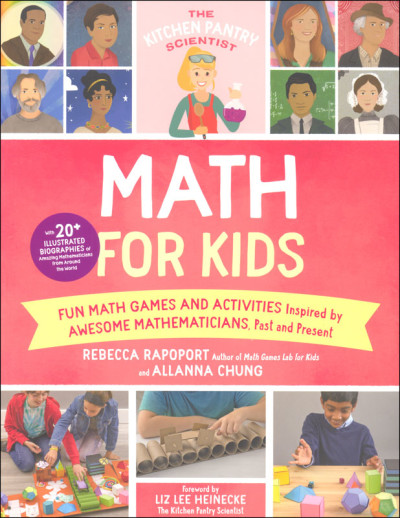We use cookies to make your experience better. To comply with the new e-Privacy directive, we need to ask for your consent to set the cookies. Learn more.
Math for Kids (Kitchen Pantry Scientist)
Bring math concepts to life for your student through this unique book, combining storytelling with hands-on learning for hours of educational fun! Includes 22 illustrated biographies from influential mathematicians around the globe, each paired with a related math game or activity. Projects, which range from simple to more complicated, have colorful, user-friendly pages with step-by-step instructions and pictures. Each activity offers “The Math in the Fun” section, ensuring that important concepts aren’t lost in the fun, while a “Bonus Level” provides another layer of difficulty for those who want it. ~Nancie
Math for Kids, the fourth book of The Kitchen Pantry Scientist series, brings math to life through biography and creative engagement. Go beyond counting. Solve puzzles, learn a magic trick, and play a ton of games.
This engaging guide offers a series of snapshots of 20+ mathematicians, from ancient history through today, paired with related hands-on projects perfect for a kitchen or a classroom. Each lab tells the story of a mathematician along with some background about the importance of their work, and a description of where it is still being used or reflected in today’s world.
A step-by-step illustrated game or activity paired with each story offers kids an opportunity to engage directly with concepts the mathematicians pursued, or are working on today. Experiments range from very simple projects using materials you probably already have on hand, to more complicated ones that may require a few inexpensive items you can purchase online. Just a few of the incredible people and scientific concepts you’ll explore: Hypatia (b. ~350–370) Square Wheels. Florence Nightingale (b. 1820) Pizza Pie Charts. Emmy Noether (b. 1882) Fabulous Folding Flexagons. Ron Graham (b. 1935) Fibbonacci Spiral. Fan Chung (b. 1949) Corners and Edges and Faces! Oh my!. With this fascinating, hands-on exploration of the history of mathematics, inspire the next generation of great mathematicians.
This resource will show you that you CAN introduce science to little kids and it CAN be easy and fun! The Chemistry for Kids lessons include the history of an inventor and a lab related to their work. For example, in lab #7 you read about William Henry Perkin and his work with synthetic dyes in 1838. He entered college at only 15 years old! He discovered a purple dye by accident and followed up. When he was 18, he applied and was awarded a patent for mauve dye which became the height of fashion. Your activity to emulate his work involves wool yarn, white vinegar, and food coloring of some sort. There are 25 labs in each book. If you are looking for a casual science option for this age group, I think kids and parents will enjoy this series. It feels like something you could do once a week. Not consumable. ~Sara
| Product Format: | Paperback |
|---|---|
| Brand: | Quarry Books |
| Grades: | 2-5 |
| ISBN: | 9780760373118 |
| Length in Inches: | 11 |
| Width in Inches: | 8.5 |
| Height in Inches: | 0.375 |
| Weight in Pounds: | 1.15 |

